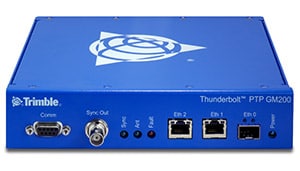Precision Time Protocol (PTP) and Network Time Protocol (NTP) Explained
Time synchronization is critical within any communication or control network. This is especially important in digital high-speed networks such as mobile phone and broadcast TV. If devices are not synchronized within your network, loss or corruption of your message data can occur. In electricity networks, precise synchronisation is critical for the deployment and control of Smart Grids. For financial transactions (even when accessing your internet bank account on your smartphone) time synchronization down to the nano-second level is critical for security, but even commercial and industrial organizations are starting to push for synchronization accuracy in the micro-second range.
The most common source of network time synchronization for internet connected devices is to use one of the public services such as pool.ntp.org, or your internet service provider will have their own NTP source. The time accuracy from these services is fine when you only need time accuracy in the order of a second. The problem with using these services for precise timing is that the public time source has to travel through switches, routers, and other network gear that all add a tenth of a second and that multiplies several times over. If you have two locations that are 100 kilometres apart and you are using the same time reference from a source located at one site, the time difference at the other site could be up to a second behind.
Of even greater concern is synchronizing different clients within the same network. Imagine a financial institution that has exactly 100 shares of Company X’s stock. Big news breaks concerning Company X, and the financial institution sells those 100 shares not to just one investor but several over the span of a second, but because the institution’s servers aren’t synchronized with one another, there is no way to tell which buy order came first.
The most secure and precise method for network time synchronization is using a local GNSS (Global Navigation Satellite System) time server as your master network clock. The time source from the GNSS network is highly accurate atomic clocks based in the satellites and synchronized with even more accurate ground stations. A GNSS based network time server provides you a Stratum 1 time source within your internal network that will be reliable, and unlike a public time server, is not impacted if the internet goes down. Up until a couple of years ago the standard network time protocol was NTP, but with much higher speeds on networks today then you have to decide whether NTP will meet the requirements, if not then you need to go to PTP. So how do you decide which protocol is right for you.
NTP Servers
NTP servers can synchronize clocks and other local network devices within microsecond accuracy, which suits most business and industrial needs for time serving accuracy.
NTP, or Network Time Protocol, has a hierarchical system with different layers called strata. Stratum 0 devices at the very top include atomic clocks, like those in GNSS satellites.
Stratum 1, or primary time servers, each have a one-on-one direct connection with a Stratum 0 clock, achieve microsecond-level synchronization with the Stratum 0 clocks, and connect to other Stratum 1 servers for quick sanity tests and data backup. Stratum 2 servers can connect to multiple primary time servers for tighter synchronization and improved accuracy, and so on and so forth. NTP supports up to a maximum of 15 strata, but every stratum slightly decreases client synchronization from Stratum 0.
A 64-bit timestamp as currently implemented is split up into two equal 32-bit parts:
- The first half counts the number of seconds up to just over 136 years
- The second half express fractions of a second down to the picosecond scale
NTPv4, designed for broadcast applications, has a 128-bit timestamp, and provides time resolution to the microsecond range. This is fine for networks that run at the IPv4 level, or wireless data comms networks run in the MB/s range.
However, if greater than microsecond synchronization accuracy is required, a PTP server might be the best bet.
PTP Servers
PTP, or Precision Time Protocol, is another network-based time synchronization standard, but instead of millisecond-level synchronization, PTP networks aim to achieve nanosecond- or even picosecond-level synchronization. For most commercial and industrial applications, NTP is more than accurate enough, but if you need even tighter synchronization and timestamping, you’ll need to migrate to a PTP server. With the introduction of faster digital networks such as 5G a PTP network is mandatory.
Why is PTP timestamping so accurate? It uses hardware timestamping instead of software, and like any other fine scientific instrument, PTP equipment is dedicated to one specialized purpose: keeping devices synchronized. For that reason alone, PTP networks have much sharper time resolutions, and unlike NTP, PTP devices will timestamp the amount of time that synchronization messages spend in each device, which accounts for device latency.
Every PTP sequence involves a series of four messages between master and slave, and this sequence produces four different timestamps. The master sends all four timestamps to the slave during the delay response phase, and the slave is able to calculate the network latency between the master and slave in both directions. By having specialized hardware fetch timestamps from the local clock, slave devices can avoid extra latency introduced by the local operating system.
NTP networks have extra latency and less accuracy simply because they’re software-based, and all timestamp requests must wait for the local operating system to respond. For most companies, NTP provides a sharp enough time resolution to resolve conflicts in a timely manner, but for a growing number of organizations a far greater level of synchronization is required. Read our article on Smart Grids for example.
Benefits of Time Server versus Public Internet Time Source
Let’s start by talking about latency. If you use a time source from your internet provider you need to understand the delays that occur through all the connections from your service providers time source to your local router. Your service provider will most likely use a GNSS Time Server to obtain UTC (Universal Time Code) to input into their network controller. Then the time code will be switch through internet switches, firewalls, through cables and more switches to finally arrive at your premises. Every time that the time code has to pass through a network node like a switch, then a delay is introduced, so by the time the time code arrives at your desk it has been delayed for a long period of time.
It may not be important that your time source is out by more than a few seconds to UTC, but if it is important then you must find another source that will give you accurate time to within microseconds to UTC. The most simple, secure and cost-effective way is to use the GNSS that allows you to place your time source within your firewall and have all your local network devices to be time synched to within a few microseconds, or with a PTP server, within nanoseconds. This is critically important if you need to have synchronised time between different locations. Because the GNSS time source from every satellite is highly accurate as well as being synchronised back to earth stations, then by using either NTP or PTP time servers in each location, the timing will be accurate to milliseconds or nanoseconds as required.
What Happens if My Time Server is Disconnected?
The GNSS network consists of multiple satellite constellations such as GPS, GLONASS, BEIDOU, QZSS, etc. and these networks also transmit time signals over multiple frequencies. So, if one satellite constellation goes down then you still have other constellations or frequencies to obtain the time code.
But if the problem is more localised, for example, your antenna was damaged during a storm, then you need to use a time server that has built in “hold-over” capability. Hold Over is where the time server has a highly stable Real Time Clock that is able to keep accurate time for the period that it takes to restore satellite signals. For highly secure installations then it is recommended to use redundant time servers with individual GNSS antennas.
Introducing the Trimble Thunderbolt NTP TS200 Time Server

The Trimble Thunderbolt® NTP TS200 Time Server is designed for demanding applications that require high accuracy NTP time stamping. The TS200 supports synchronization of thousands of workstations, routers, switches and other network elements for logging and security forensics. VOIP IPBX systems also require very accurate NTP timestamps to ensure CDR events are correctly registered and reported.
The Thunderbolt NTP TS200 supports multiple constellations GNSS, which enables tracking of GPS, GLONASS, and Beidou satellites enhancing redundancy and satellite availability.
Automation systems and industrial environments that use SCADA or other network monitoring, measurement and control systems require high precision NTP reference to ensure reliable and accurate operations.
The NTP TS200 is optimized to deliver extremely stable and accurate time of day (TOD) synchronization for a variety of time sensitive applications such as datacenters, SCADA systems and PMU synchronization.
Key Features:
- NTP v4 Time Server
- Supports 2.5K transaction/second
- Multi-Constellation (GPS, GLONASS, Beidou & Galileo)
- 15ns time accuracy (GPS locked)
- Holdover of ±1.5us over 4hours (constant temperature and when locked to GPS for 7 days)
- IPv4 and IPv6 Support
- Dedicated management port (1xRJ45)
- Network Management: SNMP, Web UI, CLI
Introducing the Trimble Thunderbolt PTP GM200 Time Server

The Trimble Thunderbolt® PTP Grandmaster Clock is designed for wireless networks requiring phase synchronization. The GM200 provides continuous availability of UTC traceable time for phase synchronization, a must for LTE- Advanced networks and services.
The Thunderbolt PTP GM200 employs industry leading Trimble GNSS solution & holdover technology.
The PTP GM200 can tolerate harsh environmental conditions supporting both indoors & outdoors deployments with extended operating temperature range.
Small cell phase synchronization:
- The Thunderbolt PTP GM200 is designed with small cells in mind but also it meets Marco base station requirements for synchronization.
- The Thunderbolt PTP GM200 supports small cells networks that require phase synchronization. The most efficient way to implement phase synchronization for LTE & LTE-A services is to deploy the grandmaster clock close to target eNodeBs to ensure 1.5 us of phase alignment.
- By reducing network hops between the grandmaster and LTE base stations, the risk of network re-configuration and load variance on IEEE-1588 signal quality is reduced. The Trimble GM200 suits this strategy perfectly due to its small size, low cost, superior accuracy & reliability and flexibility of deployment options.
Ideal for LTE-A services:
- CoMP, eICIC, eMBMS and Carrier Aggregation services require that synchronization networks be requalified and redesigned to support phase synchronization. Non- compliance with phase sync specifications will result in low or no service from LTE-A equipment and degraded bandwidth leading to potential service outages.
- By engineering current networks to support phase synchronization, LTE-A services downtime can be mitigated. Phase synchronization can easily be supported by current sync networks with the GM200 by adding it where needed. Given its low cost, it can be added to any network requiring support for the stringent phase synchronization specifications that LTE-A services require performing at their optimal levels.
- High reliability assures that the GM200 can be deployed in edge and/or aggregation networks.
Key Features:
- IEEE-1588 PTP Grandmaster Clock o Multiple PTP Profiles (G.8265.1, G.8275.1, G.8275.2, Telecom-2008 Profile, Enterprise Profile, Power Profile, Broadcast Profile SMPTE)
- Multi-Constellation (GPS, GLONASS, Beidou & Galileo)
- 15ns (1-sigma) time accuracy relative to GNSS reference
- Holdover of ±1.5us over 4hours (constant temperature and when locked to GPS for 7 days)
- Inputs: GNSS, 1588-PTP and SyncE
- Outputs: 1588-PTP, NTP, SyncE, PPS, and 10MHz
- Dedicated management port (1xRJ45)
- Network Management: SNMP, Web UI, CLI
- VLAN support
- IPv4 and IPv6
Introducing the Trimble RES 720 Multi-GNSS Timing Module

For applications that require an embedded timing receiver, the RES 720 provides secured dual band (L1/L5) GNSS timing with 5 nanosecond accuracy.
The RES 720 offers an industry leading, value- engineered solution for carrier grade timing products. It is designed to meet the resilient timing requirements mandated by the 2020 Executive Order for positioning, navigation, and timing (PNT) services.
The RES720 module offers unparalleled accuracy to meet the stringent synchronization needs of the next-generation networks in various industry verticals including 5G X-Haul, Smart Grid, Data Center, SATCOM, Calibration Services, and Industrial Automation applications.
With dual-band multi-constellation capability, RES720 reduces the timing error under clear skies to 5 nanoseconds without the need for an external GNSS correction service.
Additionally, the RES720 offers the benefit of higher power L5 signals (twice as much power as L1) with its greater bandwidth, and advanced signal design lowers the risk of interference and improves multi-path protection. The multi-band capability of the RES720 allows it to compensate for the ionosphere error while reducing the timing error under clear skies to few nanoseconds without further need for correction.
The RES720 has a single RF input for all the GNSS bands to simplify host circuitry. It uses dual SAW filters for exceptional signal selectivity and out-of- band attenuation thus providing the best total cost to performance ratio.
The RES720 offers precision time synchronization with 5 nanosecond accuracy in normal mode of operation. RES720 is designed to meet stringent timing requirements of critical infrastructure and help operators maximize the performance of their networks and optimize the return on their infrastructure investments.
With the ideals of zero trust security, the RES720 provides secure boot and anti- tampering features by default. Additionally, RES720 offers T-RAIM to provide the highest-level timing integrity.
Key Features:
- Nanosecond-level timing accuracy (5 ns 1-sigma).
- Dual Band (L1 and L5) Multi- constellation GNSS timing module.
- Protection against jamming and spoofing with Trimble’s Smart GNSS AssuranceTM
- Security features that includes secure boot, secure interface and T-RAIM.
- Supports industry standard protocols such as NMEA and TSIP for configuration and Control.
- Advanced Multi-path Mitigation capabilities to distinguish and process directly received signal from reflected signals.
Buy Timing Products

Step Global are a leading distributor of timing products. To obtain a quote or find out more about precision timing products, please contact sales@stepglobal.com or visit shop.stepglobal.com.


